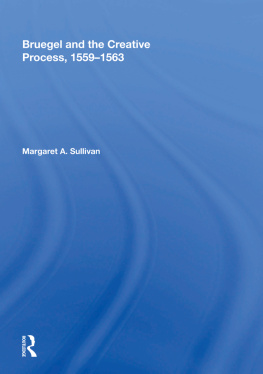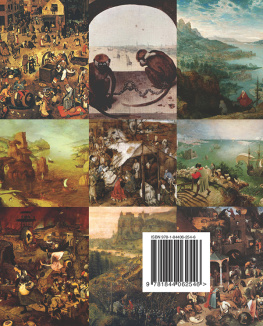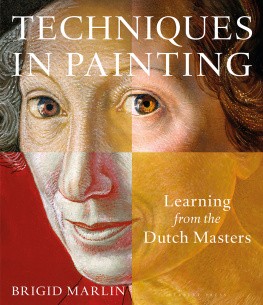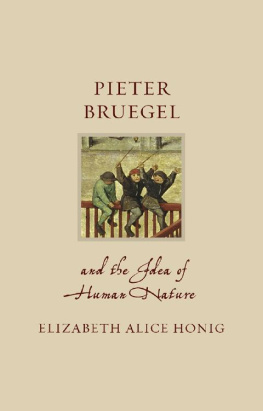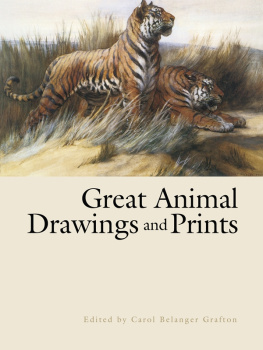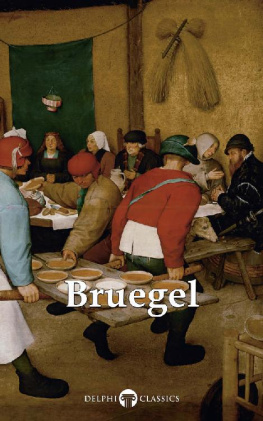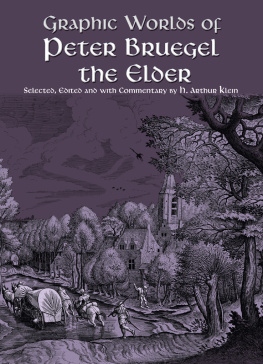Bruegel Pieter - Bruegel and the Creative Process, 1559-1563
Here you can read online Bruegel Pieter - Bruegel and the Creative Process, 1559-1563 full text of the book (entire story) in english for free. Download pdf and epub, get meaning, cover and reviews about this ebook. City: Abingdon;Oxon, year: 2018, publisher: Taylor & Francis (CAM);Routledge, genre: Home and family. Description of the work, (preface) as well as reviews are available. Best literature library LitArk.com created for fans of good reading and offers a wide selection of genres:
Romance novel
Science fiction
Adventure
Detective
Science
History
Home and family
Prose
Art
Politics
Computer
Non-fiction
Religion
Business
Children
Humor
Choose a favorite category and find really read worthwhile books. Enjoy immersion in the world of imagination, feel the emotions of the characters or learn something new for yourself, make an fascinating discovery.
- Book:Bruegel and the Creative Process, 1559-1563
- Author:
- Publisher:Taylor & Francis (CAM);Routledge
- Genre:
- Year:2018
- City:Abingdon;Oxon
- Rating:4 / 5
- Favourites:Add to favourites
- Your mark:
- 80
- 1
- 2
- 3
- 4
- 5
Bruegel and the Creative Process, 1559-1563: summary, description and annotation
We offer to read an annotation, description, summary or preface (depends on what the author of the book "Bruegel and the Creative Process, 1559-1563" wrote himself). If you haven't found the necessary information about the book — write in the comments, we will try to find it.
Bruegel and the Creative Process, 1559-1563 — read online for free the complete book (whole text) full work
Below is the text of the book, divided by pages. System saving the place of the last page read, allows you to conveniently read the book "Bruegel and the Creative Process, 1559-1563" online for free, without having to search again every time where you left off. Put a bookmark, and you can go to the page where you finished reading at any time.
Font size:
Interval:
Bookmark:

The art Bruegel produced between 1559 and 1563 presents a rare opportunity to investigate a concentrated period of productivity by one of the w greatest artists. In this brief period Bruegel produced some of his most original works-the first pictorial collection of contemporary customs Carnival in and Lent , the first painting with childrens activities as its subject Childr in ens Games , the first large-scale painting of a proverb collection, the unique enigmatic Dulle Griet (Mad Meg), and the extraordinary Triumph of Death , his disturbing vision of men and women fighting off the onslaught of death.
In this comprehensive study, Margaret A. Sullivan accounts for this burst of creativity, its intensity, innovation and brevity, by taking all aspects of the creative process into consideration-from the technical demands of picture-making to the constraints imposed by the dangerous religious and political situation.
Margaret Sullivan specializes in Northern Renaissance art of the fifteenth and sixteenth centuries. She is the author of Bruegel's Peasants: Art and Audience in the Northern Renaissance and has published her work in such journals as Art Bulletin, The Burlington Magazine, Artibus et Historiae and Oud Holland.
Margaret A. Sullivan

First published 2010 by Ashgate Publishing
Reissued 2018 by Routledge
2 Park Square, Milton Park, Abingdon, Oxon OX14 4RN
711 Third Avenue, New York, NY 10017, USA
Routledge is an imprint of the Taylor & Francis Group, an informa business
Copyright Margaret A. Sullivan 2010
Margaret A. Sullivan has asserted her right under the Copyright, Designs and Patents Act, 1988, to be identified as the author of this work.
All rights reserved. No part of this book may be reprinted or reproduced or utilised in any form or by any electronic, mechanical, or other means, now known or hereafter invented, including photocopying and recording, or in any information storage or retrieval system, without permission in writing from the publishers.
A Library of Congress record exists under LC control number: 2009047147
Notice:
Product or corporate names may be trademarks or registered trademarks, and are used only for identification and explanation without intent to infringe.
Publisher's Note
The publisher has gone to great lengths to ensure the quality of this reprint but points out that some imperfections in the original copies may be apparent.
Disclaimer
The publisher has made every effort to trace copyright holders and welcomes correspondence from those they have been unable to contact.
ISBN 13: 978-0-815-38786-2 (hbk)
ISBN 13: 978-1-351-16228-9 (ebk)
| COLOR PLATES |
| FIGURES |
To all Bruegel scholars past and present who have contributed to our understanding of his art, and to those museums and collectors entrusted with its care. I have benefited from the help of many individuals, but owe a special debt of gratitude to Dr. Alexander Wied of the Kunsthistorisches Museum in Vienna, and to Elke Oberthaler, curator for that institution. As always, the Dartmouth College Library has proven invaluable, and for the present project I have received generous assistance from Jay Satterfeld, Special Collections Librarian, and Janice B. Smarsik, Curator of Visual Resources.
I am especially grateful to my sons, Kevin, Marc, and David Sullivan, for their interest and encouragement over the years, and to my husband, Denis G. Sullivan. Without his constant support and frequent company, as I traveled from San Diego to Prague and any number of places in between in pursuit of "Bruegels," this volume would not exist. It is dedicated to him.
Margaret A. Sullivan
Norwich, Vermont
- AB Art Bulletin
- BHR Bibliothque d'humanisme et Renaissance
- CTC Catalogus translationum et commentariorum: Medieval and Renaissance Latin Translations and Commentaries, Annotated Lists and Guides (Washington, DC, 1980)
- CWE Collected Works of Erasmus (Toronto, Buffalo, and London, 1974-)
- JWCI Journal of the Warburg and Courtauld Institutes
The art that Bruegel produced between 1559 and 1563 presents a rare opportunity to investigate a concentrated period of creativity in one of the world's great artists. Within a brief period Bruegel produced some of his most original worksthe first pictorial collection of contemporary customs in Carnival and Lent, the first painting with children's activities as its subject, the first large-scale painting of a proverb collection, the enigmatic Dulle Griet (Mad Meg), and the Triumph of Death, Bruegel's disturbing vision of men and women in a desperate fight against the onslaught of death. Each of these paintings is unique, yet they share a similar size and format, a panorama filled with a multitude of individual figures and intriguing details.
Idiosyncratic, as original in conception as they are skillful in execution, the paintings Bruegel created during these years form a unique body of work that raises a number of important questions. What combination of circumstances made this burst of creativity possible? And why did it end as suddenly as it began? After 1563 the majority of Bruegel's subjects can be accommodated within a familiar category. The strange gave way to the traditional with subjects that his viewers could readily identifyseasons, peasant scenes, religious subjects such as the Carrying of the Cross, or, in the case of his Fall of Icarus, a familiar classical story. It was only at the end of his life with the Magpie on the Gallows and the Misanthrope, painted in 1568, the year before his death, that Bruegel again made such a radical break with tradition. What experience, interests, and abilities did Bruegel bring to the creative process, and what was the mediating role of external factors over which the artist had no control?
The aim in this study is to address these questions by constructing a coherent account of Bruegel's art and career during these crucial years, one that includes all the extant works, drawings as well as paintings. The factors to be considered include the technical problems associated with picture-making, Bruegel's personal situation at the time, his previous works, the demands of the marketplace, the influence of other artists and their art, the role of patrons and publishers, the experience and expectations of the potential audience, the literature published at the time, and the impact of the religious and political this is a comprehensive, chronologically organized enterprise. Aside from the copies of Bruegel's paintings made by his sonsincluded because they provide a unique insight into the father's creative processrelevance is determined by timing and specificity.
Because the works that Bruegel produced between 1559 and 1563 differ to such a marked degree from the more traditional subjects that followed, preconceived notions based on later circumstances can be misleading. In this study events and attitudes appropriate to this period under consideration are given precedence over anachronistic assumptions based on work that Bruegel produced after that time as well as his posthumous reputation. Although Karel Van Mander's biographical sketch in his Schilder-Boeck of 1604 is usually given an important role in studies of Bruegel's art it tends to reveal more about Van Mander's own proselytizing agenda and Bruegel's reputation as it developed after his death than it does about the art he created between 1559 and 1563. Van Mander's particular concerns, as well as the intervening years, compromise the reliability of the Schilder-Boeck when reconstructing the social and cultural conditions that prevailed in the middle of the sixteenth century.
Font size:
Interval:
Bookmark:
Similar books «Bruegel and the Creative Process, 1559-1563»
Look at similar books to Bruegel and the Creative Process, 1559-1563. We have selected literature similar in name and meaning in the hope of providing readers with more options to find new, interesting, not yet read works.
Discussion, reviews of the book Bruegel and the Creative Process, 1559-1563 and just readers' own opinions. Leave your comments, write what you think about the work, its meaning or the main characters. Specify what exactly you liked and what you didn't like, and why you think so.

